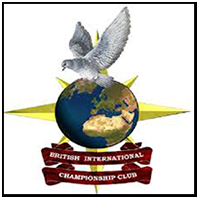BRIAN BATCHELOR OF ELSTEAD
5th & 10th Open L&SECC TARBES 550 miles
9th Open BICC Pau 550 miles
by Keith Mott
Being the Chief Convoyer for the London & South East Classic Club, I’m very happy to report that our 2008 Tarbes Classic was one of the best of all time, with a good number of my charges being clocked on the day of liberation. Brian Batchelor had one of the best pigeon weekends of his life, recording two birds on the day from the Tarbes Classic and timing his sole entry in the Pau International event.
The first bird on the clock from Tarbes, to record 5th open, was a two year old blue chequer hen named ‘Dani’, after Brian’s little granddaughter. He tells me she has always been a consistent racer and showed her potential as a young bird in 2006, when she won 2nd Portland in the very strong Godalming club. This season she came from the BICC Falaise race with most of her secondary flights on one wing ripped out by a hawk, but bounced back and was the first bird on the clock from the BICC Alencon event. Brian’s second bird from Tarbes, to record 10th open, was his good pied hen, ‘Baby’, and she is the tamest bird in the loft, being his pet, and flying to him outside the loft. She was his second bird clocked on the day from the successful 2007 L&SECC Pau race, when she won 56th open and was found in the loft after returning from getting his clock checked at Godalming. Brian says he had the ETS on training mode and it showed she had been home for 49 minuets before he clocked her. A very good hen!
‘Dani’ and ‘Baby’ are half sisters, being bred from the same Van Breemen stock hen and are closely related to Tony Dann’s 2008 6th open NFC Angers winning hen, ‘First Lady’.
In the 2008 Pau International race Brian recorded his four year old blue white flight hen ‘Patience’ and she won 9th open BICC. She was a gift youngster from Darryl Luxford of Crawley and Brian said she had been late from every race she had been entered in, short or long, and was retained after she finally recorded 4th club Exeter on a dirty day. This year she was flying spare, after her mate was lost, and flew a ‘blinder’ from the Pau International. Congratulations to Brian on his wonderful weekend in June!
The L&SECC enjoyed one of its best Pau Classics in 2007 when over 100 birds were clocked on the day of liberation, from the convoy I liberated that day in the South of France. Two of those day pigeons were recorded at the loft of Brian Batchelor, in his Elstead Post Office garden. To say Brian was chuffed at getting two day pigeons from Pau (540 miles) on his first attempt at this race point would be an under statement! The first bird on the clock from Pau was a two year old Eric Cannon blue hen named ‘Jeanie’, and she was bred from two gift latebreds from my stock loft. Brian told me he has named his wonderful hen ‘Jeanie’ in honour of his good wife, who puts up with the exorbitant amount of time Brian spends with the pigeons without complaint. This game hen was 12 hours 7 minutes on the wing from Pau and recorded 19th SW section, 35th open. Her dam was a blue hen from my Number 2. Eric Cannon stock pair, was killed in Brian’s garden last year by a Sparrow Hawk, but has left some real quality racers behind her.
I consider Pair 2. to be the best breeders I have ever owned, producing an ever growing list of premier long distance racers. The pairing is blue cock, “Culmer Prince”, bred by Eric & Pat Cannon of Wormley. Sire of winners and a son of Ch. “Culmer Marion”, winner of 1st open NFC Sartilly, when mated to a daughter of “Culmer Expected”, winner of 22nd, 27th, 103rd, 231st open NFC Pau. The dam is blue hen, “Culmer Rocket Queen”, bred by Eric & Pat Cannon. The best hen I’ve ever owned! Dam of winners and a daughter of “Culmer White Flight”, winner of many positions in the NFC, including 1st sect, 14th open Pau when mated to Champion “Culmer Channel Queen”, winner of 23rd, 29th, 98th, 183rd open NFC Pau and winning the NFC Pau Merit Award.
The sire of ‘Jeanie’ is a blue cock bred out of my Number 3. Eric Cannon stock pair and still resides in Brian’s stock loft. Pair 3. are: “Culmer Sam’s Lad”, bred by Eric & Pat Cannon. Sire of winners and a son of Champion “Culmer Sam”, winner of 89th open NFC Pau and the ultimate stock cock. The sire of Eric Cannon’s loft. The hen of Pair 2. is “Culmer Fantasy”, bred by Eric & Pat Cannon. Dam of winners and daughter of Ch. “Culmer Bess”, winner of 6th, 26th, 170th open NFC Pau, 47th open NFC Pau / Saintes and winner of the NFC Pau Merit Award. Highest priced pigeon at Eric Cannon’s dispersal sales. Sold for £2,300. “Culmer Fantasy” is a full sister to the dam of Ch. “Night Flight”, winner of 1st open NFC Pau / Saintes in 2003 for Mark Gilbert. This wonderful pair of Eric Cannon pigeons have bred many premier racers, including Gordon Marsh’s 17th open B.I.C.C. winner, Fred Birch’s day pigeon in the 2008 NFC Tarbes Grand National and a couple of 1st Federation Bourges (560 miles) winners for Fred Dixon in the North East of England.
‘Jeanie’ flew the very hard Bergerac (440 miles) as a yearling in 2006 and showed some great potential by being second bird to the loft. This season she was mated in mid-February and after rearing two youngsters was separated, after leaving her second round of eggs at the end of term. Her pre-race training was three tosses of the south coast, near Portsmouth, then into the L.& S.E.C.C. Alencon (193 miles) race, then was sent to Poitiers (321 miles) with the S.M.T. Combine, which turned out to be a very event. She appeared in the club and Combine result from Poitiers and the 9 hour 35 minutes on the wing set her up nicely for the Pau Classic.
The second pigeon Brian clocked to record 30th SW section, 56th open from the Pau Classic was the Van Breemen hen, ‘Baby’, bred from a very good hen obtained from Tony Dann of Leatherhead. Tony was Chairman of the Three Borders Federation for several years and is one of pigeon racing sports gentlemen. Tony has a very good line of the Van Bremen pigeons, originally obtained through his late father, Wally Dann of Cobham. Brian is crossing these birds out with the Eric Cannon and Jim Biss pigeons with outstanding success.
Brian owns the Post Office in the village of Elstead in Surrey and his very smart little loft is sited in the garden of the premises. He is only a small team man, about 50 pigeons in all, including old bird racers, young birds and his stock team. The old birds are raced on a celibate system and the racers only see their mates on race day or returning home from training tosses. Brian says his system is very similar to widowhood, but he races both the hens and cocks. Working where his pigeon are he can keep to a tight routine, with the cocks getting an open hole for 3 hours in the morning, the hens getting the same in the afternoon and young bird team have their fly in the evening. They are fed on Buckton’s Economy protein mixture and standard widowhood mixes. They also get Old Hand Golden Boost, Versalaga Pellets, minerals and only GSE purifier is added to the drinking water once a week. Brian tells me no medication is used in the off season, but during the racing season he has a medication regime. In the week between races the birds get one or two training tosses from about 30 miles, if possible in to the wind regardless of direction. His young birds receive ten tosses and then three or four races, before being stopped to finish their very import moult.
Prior to starting up with pigeons at Elstead in 2004 Brian had racing pigeon in New Zealand where he had lived most of his life before returning to England permanently, the country of his birth. In New Zealand he had pigeons off and on since he was eleven years old and tells me he had some good success at times. Two memorable races in New Zealand were in 1994 when he was 2nd, 3rd Young Birds National and 1st Section, 2nd overall Auckland Federation Timaru (560 miles), with the same pigeon recording 5th Section, 5th overall in the same race the following year, which was flown on the day in 13 hours 26 minutes. He also still holds the record in one club he belonged to, when his pigeon flew 453 miles in 8hours 27 minutes. In the later years of his New Zealand pigeon racing he flew in partnership with Digby Riemann, under the flying name of Royal Oak Lofts and scored numerous positions including 3rd, 4th, 6th Auckland Futurity, 3rd Young Bird National on a hard day and 2nd section, 2nd Federation overall Timaru (560 miles).
In New Zealand the old birds are raced in the Spring and the young birds in the Autumn, so the weather conditions are often windy, with some rain. The numbers in the races down under are less than in Britain, reflecting the small population; never the less competition is fierce between the premier flyers. Members belong to a single club which is part of a regional Federation and that is; there is not the fragmentation of the sport into a proliferation of specialist clubs like we have here in Britain. Long distance racing is flown between the North and South Islands crossing the stretch of water between known as, ‘Cooks Straight’, named after the famous explorer Captain James Cook. Like channel racing in England, this water crossing can be treacherous when the weather turns bad, but generally the crossing is made in mid afternoon, rather than in the evening, like we some times do racing in the south of England. One major difference racing in New Zealand is that the Hawks are few and far between and clashing is the exception, consequently losses are low and they always end the season with surplus pigeons. Brian said, ‘on a controversial subject in the U.K. the vast majority of pigeon racers in New Zealand use ETS clocking and clubs have made it available to all members on a normal rent to buy basis, so all can afford it’.
Between 1950 and 1993 there were no pigeons imported in to New Zealand, so strains of pigeons were developed locally from the original imports prior to 1950, the most successful of these were developed from the Logans, Geooters, Stassarts, Van Cutsem and Vandeveldes, with the later being the most prominent strain. However over the years these strains tended to become ‘stayers’ and when the Janssen, Busschaerts and De Vriends were introduced in the early 1990’s via Australia, these new sprint families left the local pigeons in their wake up to 300 miles and none of the New Zealand strains could touch them. Eventually everyone had to introduce the new imports in to their lofts to compete and some of those crosses with the old strains performed well at the long distance.
There you have it, the Brian Batchelor story! That’s my article for this week. Any pigeon comments to me on telephone number: 01372 463480. See yer!























